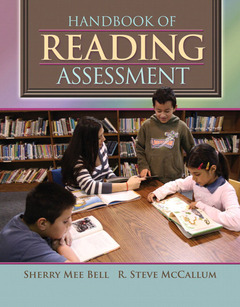Description
Handbook of reading assessment
Authors: MEE Bell Sherry R., MCCALLUM Steve
Language: English
Approximative price 52.85 €
Subject to availability at the publisher.
Add to cart384 p. · Paperback
Description
/li>Contents
/li>
This much-needed resource addresses the wide range of reading assessments educators must be able to use and understand to effectively assess, instruct, and to communicate across disciplines. Separate chapters focus on informal classroom based assessment, progress monitoring, individual norm-referenced assessment, and group norm-referenced or 'high-stakes' testing. Each of these chapters concludes with useful tables listing some of the most commonly used assessments and their psychometric properties.
Rationale
Educators Speaking the Same Language
Inclusive Coverage of Reading Assessment
CHAPTER 1 ASSESSMENT OF READING: THE CONTEXT
Teachers in Action
Meet Lesa Crockett
Meet Greg Haywood
Meet Harley Charles
Meet Maria Sanchez
What is the Role of Assessment in Instruction?
What Do Teachers Need to Know About Reading Assessment?
Purposes of Assessment
Instructional Planning
Progress monitoring
Accountability
Eligibility for Special Education Services
What is Reading?
What Are the Critical Areas of Reading?
What is the Multitiered Model of Instruction?
What is Scientifically-Based Research in Reading?
Appreciating Effective Research
Peer-Reviewed Journals
Reviewing and Using Evidence Based Research Findings
What is a 'true experimental' design?
What is a 'quasi-experimental' design?
What is a correlational design?
What is a single subject design?
Quantitative versus qualitative research.
What is a qualitative case study?
What is Action Research?
How Does Scientifically-based Research Help Teachers in the Classroom?
What are the Reading Wars and How are They Related to Assessment?
What are the Major Types of Assessment?
Summary
CHAPTER 2 NATURE OF READING
Historical Context for Models of Reading
Developmental Models of Reading
Chall's Stage Model of Reading
Spear-Swerling and Sternberg Model of Reading
Frith's Developmental Phase Model
Adam's Cognitive Model of Reading
Information Processing Model of Reading
What is the Relationship Between Reading and IQ?
Transactional View of Reading
Speaking, Reading, and Writing
An Inclusive View of Reading
How Do We Know if a Student Has a Reading Disability?
How do We Distinguish English Language Learning Challenges from Disabilities?
Low Literacy Adults
The Literacy Instruction Pie
Using Knowledge of Reading to Understand Reading Assessment
Summary
CHAPTER 3 INFORMAL ASSESSMENT: INFORMING INSTRUCTION
Observation and Interview
Teacher-Made and Teacher-Selected Curriculum-Related Assessment
Specific Skills Assessments
Error Analysis
Informal Reading Inventories
Getting Started with the IRI
Quantitative Analyses of IRIs
Qualitative Analyses of IRIs
Abbreviated Assessment with IRIs
Using IRIs to Assess Listening Comprehension
Teacher-Made IRIs
Limitations of IRIs
Running Records
Curriculum Based Assessment
Using Teacher-Constructed CBM to Assess Reading
Portfolio Assessment
Readability
Leveled Texts
Special Considerations in the Informal Assessment of Young Children
Special Considerations in the Informal Assessment of Adults
Special Considerations in the Informal Assessment of English...




